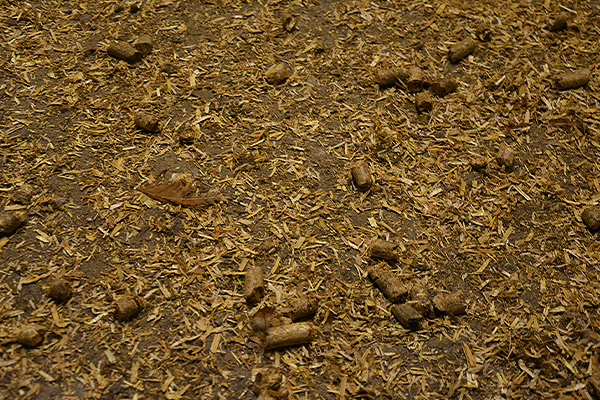Like the hen like the egg
Chickens lay the best eggs when they are well nourished, have plenty of space and can pursue their individual needs. Philipp Benger, who produces around 80,000 eggs a week on his farm in Rheurdt-Schaephuysen on the Lower Rhine with almost 15,000 free-range laying hens, knows this too. “Outdoors, the chickens can bathe and scratch in the sand during the day, eat grass and insects and find protection from birds of prey or other dangers in the hedges. But overnight and in inclement weather, the chickens stay in the chicken shed. And there, too, the animals should live as species-appropriate as possible,” explains Benger.


The rule here is: less is more
When planning the chicken shed, it was initially still undecided which litter material should be used there. According to Benger, the decision was made rather by chance: “During the excavation work, I got into conversation with the civil engineering contractor who is a friend of a contractor. The contractor in turn had told him about straw pellets which he produces from grain straw using a mobile pellet press. Shortly afterwards, I contacted the contractor and immediately ordered a few tonnes of the structural pellets after the chicken shed was completed”.
In accordance with the general recommendation of his supplier, the farmer initially applied about 4 kg/m2 of pellets on the shed floor. But shortly after applying them, he realised that this amount was clearly too high: “The structural pellets proved to be extremely absorbent, so that they formed a mat several centimetres thick after absorbing moisture. That was too much for our conditions. If the litter layer is too thick, the hens quickly build nests in all possible corners and lay some of their eggs there instead of in the designated laying nests which are automatically emptied regularly by conveyor belts. This inevitably leads to higher losses due to lost, soiled and broken eggs,” explains Benger.
Easy handling
The farmer has learned from experience and now knows how to dose the structural pellets correctly in his shed: “To house the pullets, we now apply the equivalent of a maximum of 400 g/m2 on the floor. In principle, these are only homeopathic quantities – but that is quite sufficient here,” says Benger. He brings the pellets, which are delivered in Big Bags, in a wheelbarrow into the shed and dumps them out on the floor. Immediately, the curious chickens rush over and spread the almost germ and dust-free pellets evenly over the entire floor. In doing so, they peck at the straw pellets so that they gradually crumble. “About three weeks after application, the pellets have largely dissolved and mix with droppings and alfalfa hay which we also offer the chickens as manipulable material. This eventually forms a loose ground mat which constantly absorbs moisture and prevents the droppings from sticking to the ground. This not only keeps the hens’ feet clean, but also the eggs they lay in the laying nests,” enthuses Benger.

The farmer estimates the consumption of structural pellets for the approximately 2,500 m2 of litter in the shed at a good 1 t per year. The straw pellets are spread on the floor only once when the pullets are housed, no further spreading is required. This is because a large part of the droppings excreted by the chickens is transported out of the shed via the droppings belts underneath the perches and grates of the aviary racks. Therefore, only a small proportion of the manure comes into contact with the straw pellets.

No more problems with feather pecking
Besides their function as litter, the structural pellets have another effect which is just as important, according to Benger: “As the chickens can peck at the pellets all the time, feather pecking problems are also a thing of the past. In this respect, the structural pellets are a good addition to the pecking stones placed in the shed. Since 2017, beak clipping has been banned, so that without suitable manipulable material the chickens try to live out their natural pecking behaviour on their conspecifics. In extreme cases, this may result in downright cannibalism in which a number of animals will die in agony.
Sustainable and species-appropriate
“On the packaging of our eggs we advertise with the slogan “From the region, for the region”. In accordance with this motto, we market most of the eggs within a radius of around 50 kilometres. The fact that we use the straw produced on our fields in the form of pellets as litter and manipulable material therefore fits very well into the Benger farm concept. In this way, we ensure animal-friendly husbandry and sustainable production of our products”, concludes the farmer.

Contact
Do you have any further questions and would like to contact us? The contact form is the easiest way.